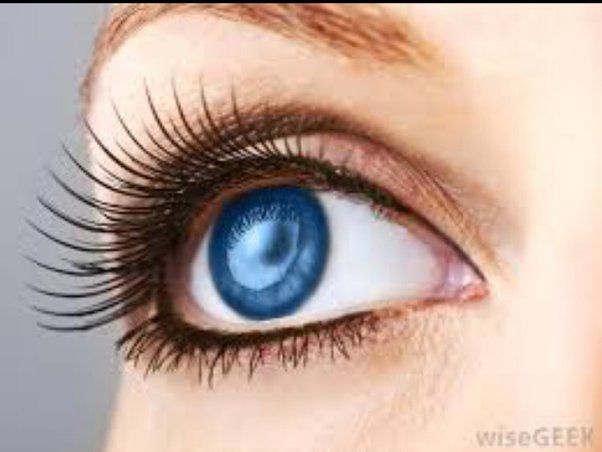What Does It Mean When Someone Is Glazed?
A “glazed look” or “glazed expression” refers to when someone’s eyes appear glassy, unfocused, blank, expressionless, or lacking alertness or intensity. A glazed look typically conveys detachment, an absence of response, or a lack of energy, interest, or comprehension. This look in someone’s eyes reveals that they are not fully present, engaged, or attentive.
Physical Appearance
When someone is described as having “glassy eyes,” it typically refers to their eyes appearing glossy, glazed over, blank, or unfocused (Source). The surface of the eye often looks shiny or wet instead of clear and sharp. Many compare the appearance to eyes made out of glass, hence the term “glassy eyes.”

Physically, glassy eyes occur when the tear film over the surface of the eye becomes compromised or uneven. The tear film is crucial for protecting the eye and keeping it moist. When the tear film is disrupted, it can cause the light to refract unevenly off the eye’s surface, creating a glassy look (Source).
Glassy eyes may look unfocused, distracted, blank, or simply abnormal. The person’s gaze may seem vacant, distant, or unaware. Often the eyes lack their usual lively, engaged appearance and instead look dulled or glazed over.
Lack of Focus/Awareness
One common reason someone may have a glazed look is a lack of focus or awareness of their surroundings. This can involve staring blankly into space without really seeing or processing what is in front of them. When someone’s attention is turned inward or they are lost in thought, their eyes can take on a vacant, glazed over appearance.
Some examples of when someone might exhibit this glazed stare due to lack of focus include:
- Daydreaming – Being lost in thought about something unrelated to the present moment.
- Spacing out – Brief moments of losing focus or concentration.
- Disassociation – Detaching from one’s immediate surroundings as a psychological defense mechanism.
- Brain fog – Having difficulty thinking clearly or concentrating.
In these cases, the glazed stare signals that the person’s mind is elsewhere and they are not engaged with what is directly in front of them. It is often an involuntary, temporary lack of awareness where the person may be staring blankly ahead. With some effort or an external stimulus like being spoken to, the person can typically regain focus.
Fatigue/Exhaustion
One of the most common causes of glazed eyes is fatigue or exhaustion. When someone is extremely tired, their eyes can take on a glassy, unfocused appearance. This happens because the ocular muscles become fatigued and have a hard time keeping the eyes open and moving properly. According to a study by Sundelin et al. https://www.ncbi.nlm.nih.gov/pmc/articles/PMC3738045/, some of the most common signs of fatigue in the eyes include hanging eyelids, red eyes, swollen eyes, and glazed eyes.
Fatigue reduces blink rate and causes the eyes to stay open for longer periods. This dries out and irritates the eyes, making them appear shiny. The lack of rest, sleep deprivation, and physical exhaustion all contribute to the glassy-eyed look. People who are extremely tired may have trouble focusing their vision or keeping their eyes open fully. Their eyes can flutter closed then jerk back open again involuntarily. Overall, the eyes lose their lively appearance and take on a flat, faded, glazed look.
Intoxication
Being “glazed” can often refer to someone appearing intoxicated or under the influence of drugs or alcohol. Intoxicating substances like alcohol, marijuana, opioids, stimulants, and others can cause a number of physical effects that give the appearance of being glazed.
Some common signs of intoxication that may lead to a glazed look include:
- Dilated or constricted pupils (https://www.webmd.com/mental-health/addiction/what-to-know-substance-misuse-eye-changes)
- Droopy or heavy eyelids
- Bloodshot eyes
- Glassy, unfocused eyes
- Lack of eye contact or inability to track movement
When intoxicated, people often appear dazed, distracted, and unable to focus visually on their surroundings. Their eyes may point in different directions or wander aimlessly rather than looking at any one thing. Overall, the eyes take on a glazed, glossy look lacking alertness.
If someone appears potentially dangerously intoxicated, it’s important to seek medical help or call a helpline like SAMHSA’s National Helpline (https://www.samhsa.gov/find-help/national-helpline) to get them treatment and keep them safe.
Illness
Certain illnesses and medical conditions can cause a person’s eyes to appear glassy. Some examples include:
Fever – A fever is often accompanied by glassy eyes. The high body temperature causes dehydration, which leads to dry eyes. Infections that cause fever, like the flu, cold, strep throat, and ear infections, frequently result in glassy eyes.
Infection – Bacterial and viral infections, especially those affecting the sinuses, throat, and ears, can lead to glassy eyes. Infections cause inflammation that dries the eyes. Pink eye, sinusitis, tonsillitis, laryngitis, and ear infections often produce glassy eyes.
Graves’ Disease – This autoimmune condition impacts the thyroid, causing it to produce excess hormones. The bulging eyes (exophthalmos) that sometimes occur with Graves’ disease can appear glassy. Other symptoms include anxiety, tremors, weight loss, and goiter.
Diabetes – Uncontrolled diabetes can lead to extremely dry eyes that take on a glassy look. High blood sugar causes fluid loss, resulting in insufficient tear production. Other diabetes symptoms include increased thirst, frequent urination, fatigue, and slow wound healing.
Sjögren’s Syndrome – Sjögren’s syndrome stops glands from producing tears and saliva. The chronic dry eyes and mouth caused by this condition often manifest as glassy eyes. Joint pain, dry skin, dental cavities, and fatigue are also common.
Mental Health
Various mental health conditions can cause someone to appear glazed or disconnected. Depression, dissociation, and trauma are particularly associated with a glazed look.
In depression, a glazed or vacant stare may signal fatigue, loss of interest, and emotional numbness. Research shows depression is associated with a flat affect and gaze avoidance.
Dissociation often manifests as a disconnected, faraway stare. Trauma and post-traumatic stress disorder (PTSD) can also lead to dissociation and a detached gaze. In dissociation, it may seem like no one is home behind the eyes.
Overall, glazed eyes can reflect psychological distancing and disconnection from one’s surroundings. This may represent an attempt to cope with difficult emotions or past trauma. Treatment such as psychotherapy and medication can help address the root causes.
Boredom
A glazed look can also signify boredom or disengagement. When someone is extremely bored by a situation, their eyes may take on a glassy, unfocused appearance from zoning out or daydreaming. As this source explains, a glazed look often emerges when we feel understimulated and withdraw into our own thoughts. Our eyes become detached from what’s in front of us as our minds wander elsewhere. A glazed look during a conversation, presentation, or activity may reveal boredom, lack of interest, or the urge to mentally check out. Reddit users share similar experiences, like noticing a glazed look in others when rambling about a topic they find dull.[1] In these situations, the eyes mirror a disengaged mind adrift in its own imagination.
Lack of Interest
A glazed look can sometimes indicate a lack of interest, enthusiasm, or motivation. When someone is feeling indifferent or apathetic about a situation, their eyes may appear disengaged and distant. This type of glazed look often signifies boredom, distraction, or an inability to focus on the present moment.
According to the Collins American English Thesaurus, some synonyms for a “glazed” look in the context of lacking interest include: expressionless, dull, vacant, lifeless, and unresponsive (Collins). The word “glazed” evokes a sense of someone’s internal spark or light being dimmed by disinterest.
Individuals with mental health conditions like schizophrenia may also exhibit a glazed look in their eyes due to a lack of motivation or an inability to express enthusiasm. According to HelpGuide, two common symptoms of schizophrenia are “Lack of emotional expression – Inexpressive face, including a flat voice, lack of eye contact, and blank or restricted facial expressions” and “Lack of interest or enthusiasm – Problems with motivation; lack of self-care or hygiene; no interest in everyday activities or relationships” (HelpGuide).
Conclusion
Being glazed is generally characterized by a lack of focus, awareness, and engagement. It can be caused by fatigue, illness, intoxication, boredom, or lack of interest. The main signs are a blank stare, slow responses, lack of eye contact, and an apparent inability to pay attention. While it may look similar to daydreaming, being glazed implies a more extreme disconnect and lack of energy. Recognizing when someone appears glazed can help identify underlying issues that need addressing through rest, care, or medical treatment. Overall, glazing signals a temporary or prolonged state of detachment from one’s surroundings.


